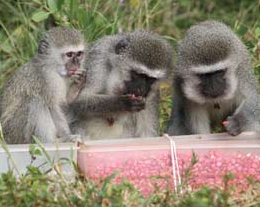Please note: Osher Rainforest will be closed for maintenance Jan. 14–16.
Science News
When in Rome...
April 26, 2013

by Molly Michelson
Not everything is passed down through genes. Many of our human actions result from cultural influences: “a collective adoption and transmission of one or more behaviors among a group” (from ScienceNOW). The skills, knowledge, materials, and traditions that humans learn from each other help explain how we have come to dominate the globe as a species.
But we’re not the only species on our planet with culture. Scientists are discovering that more and more animals—from mammals to birds to fish—use cultural transmission for species survival. Studies in this week’s Science focus on two: humpback whales off the coast of Maine and vervet monkeys in South Africa.
Humpback whales around the world hunt small fish collectively by producing “bubble nets”—the whales blow bubbles around a school of fish while slowly advancing toward their next meal. In 1980, in Maine, one whale was observed hitting the water with its tail before producing the bubble nets. This innovation, called “lobtail feeding,” spread throughout the population over several decades. By 2007, nearly 40% were doing it.
Researchers believe that a crash in the herring population that these humpbacks fed upon drove them to new solutions to catch other fish, primarily sand lance.
Co-author of the study, Luke Rendell, of the University of St. Andrews, says, “Our study really shows how vital cultural transmission is in humpback populations—not only do they learn their famous songs from each other, they also learn feeding techniques that allow them to buffer the effects of changing ecology.”
St. Andrews researchers also found that vervet monkeys learned from each other in a changing environment. In the initial study, the scientists provided a group of monkeys in the wild with a box of corn dyed pink and another dyed blue. The blue corn was made to taste repulsive and the monkeys soon learned to eat only pink corn. Another group was trained in this way to eat only blue corn.
A new generation of vervet monkeys were later offered both colors of food—neither tasting badly—and the adult monkeys present appeared to remember which color they previously preferred.
Almost every infant copied the rest of the group, eating only the one preferred color of corn. The crucial discovery came when males began to migrate between groups during the mating season. The researchers found that of the ten males who moved to the group eating a different colored corn to the one they were used to, all but one switched to the new local norm immediately.
Erica van de Waal, lead author of the study, says, “The copying behavior of both the new, naïve infants and the migrating males reveals the potency and importance of social learning in these wild primates, extending even to the conformity we know so well in humans.”
Her colleague, co-author Andrew Whiten, agrees. “It may make sense in nature, where the knowledge of the locals is often the best guide to what are the optimal behaviors in their environment, so copying them may actually make a lot of sense… ‘When in Rome, do as the Romans do.’”
Image: Erica van de Waal